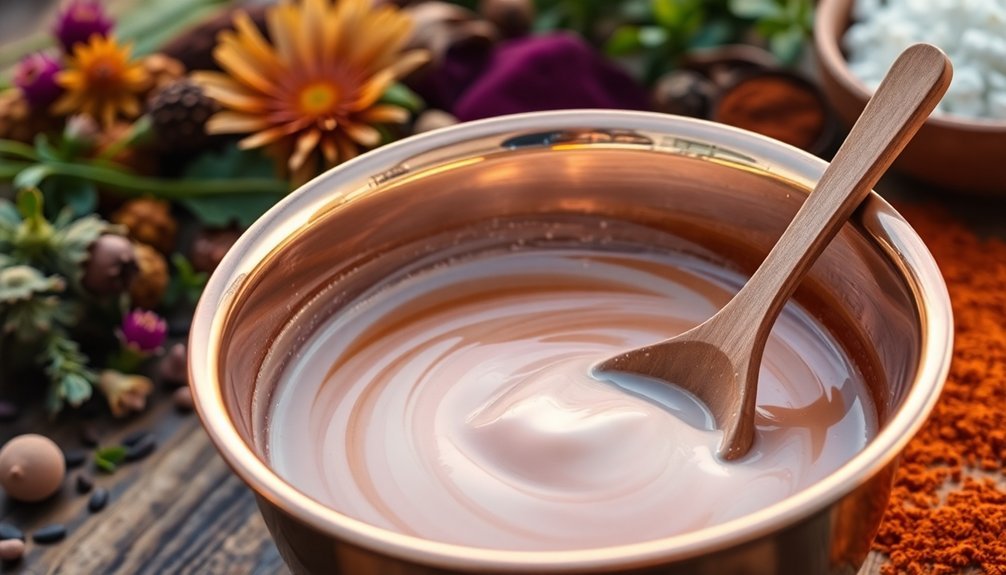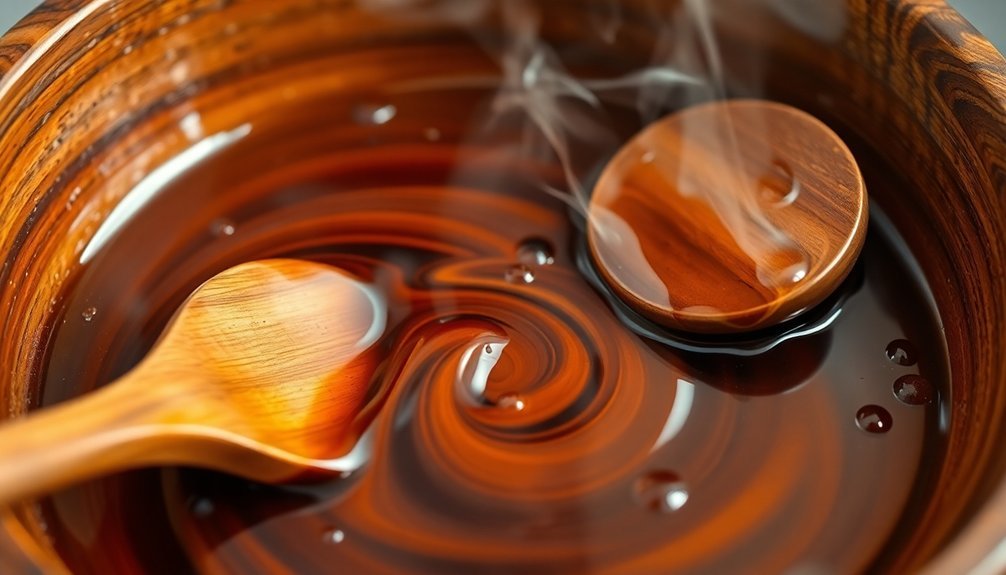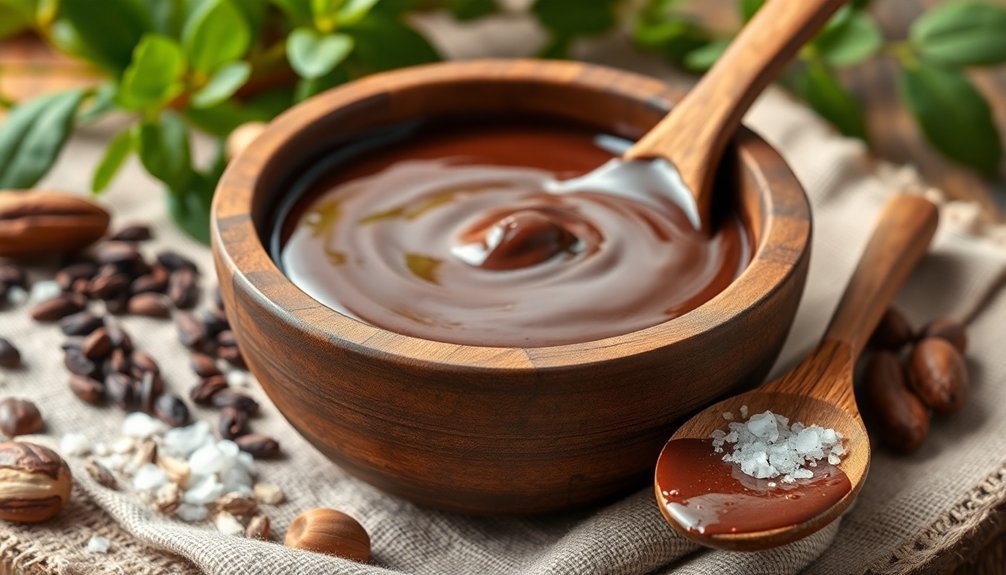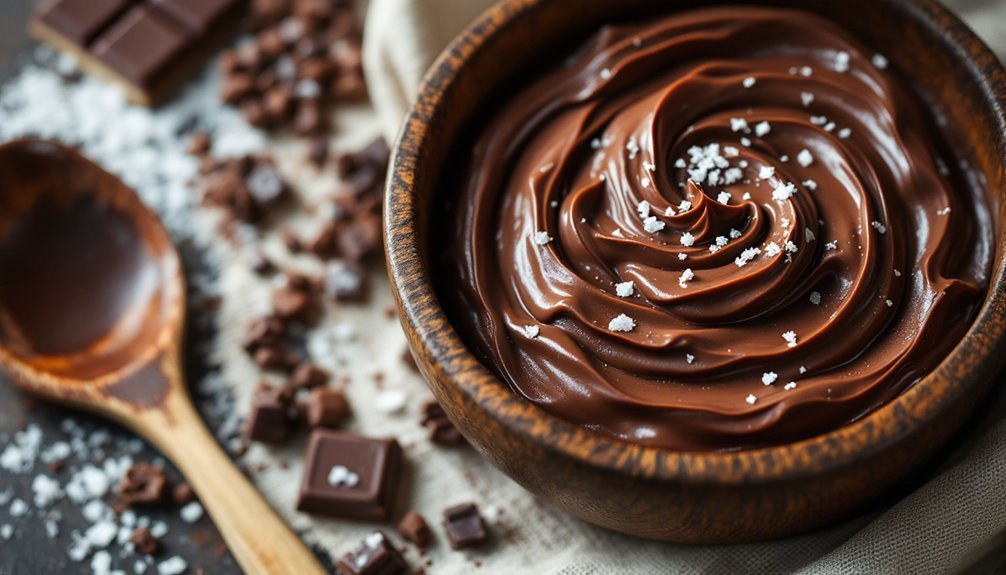Hand mixing gives you unparalleled control over your artisan soap bars. You'll maintain ideal temperatures (135-145°F), prevent over-mixing, and preserve essential oil integrity better than with mechanical methods. This slower saponification process allows you to adjust pH levels and consistency in real-time, resulting in superior texture and aromatic profiles. Hand stirring also transforms soapmaking into a meditative practice, connecting you deeply to your craft. Discover why this traditional technique creates bars that truly stand apart.
The Art of Slow Saponification Through Hand Stirring

While modern soapmaking often relies on electric stick blenders for efficiency, hand stirring represents the essence of artisanal soap crafting. This time-consuming process offers you intimate control over the saponification journey, allowing oils and lye to combine at a naturally measured pace.
You'll notice how different oils behave—olive oil slows trace while castor accelerates it. By maintaining temperatures between 135-145°F and selecting recipes with higher saturated fats, you can optimize your stirring efficiency without rushing the process. The traditional approach may require hours or days to reach trace, depending on your recipe selection and technique.
Hand stirring minimizes the risk of over-mixing, which is common with blenders. This slower approach gives you the freedom to observe the subtle changes as emulsification occurs, deepening your understanding of soap chemistry while creating a uniquely personalized product that honors traditional craftsmanship.
Sensory Benefits of Manual Soap Mixing Techniques
You'll gain exceptional control over textural nuances when hand mixing soap, allowing you to create everything from silky-smooth bars to those with exfoliating properties.
Manual techniques enhance the aromatic profile of your soaps by letting you carefully fold in essential oils at precise moments during the mixing process.
Your hand movements directly impact bubble formation dynamics, creating either dense, creamy lather or large, fluffy bubbles depending on your stirring patterns and intensity. For maximum sensory appeal, incorporate citrus essential oils like grapefruit and mandarin orange to create refreshing and invigorating scent profiles.
Textural Nuance Control
Beyond the chemical science of saponification, hand mixing offers artisans extraordinary control over textural nuances in soap—an advantage that machine production simply can't replicate.
When you manually blend your soap mixture, you'll achieve precise control over temperature, mixing speed, and ingredient incorporation. This prevents over-blending that would otherwise result in dense, texture-less bars. The careful attention to detail reflects the artisanal methods and traditional techniques that contribute to the overall quality and character of handmade soaps.
You can carefully introduce exfoliants like oatmeal or coffee grounds, adjust the consistency based on real-time observations, and even create multi-textured bars through skilled layering techniques.
The manual process also guarantees natural glycerin retention, contributing to that moisturizing quality your customers love. Each stroke of your mixing tool allows for artistic expression, resulting in visually appealing patterns that transform simple cleansing bars into sensory experiences worth savoring.
Aromatic Profile Enhancement
The delicate symphony of scents in artisan soap begins with the simple act of hand mixing. When you manually blend your soap, you'll preserve essential oil potency and create more stable fragrance profiles than machine mixing allows. Without excessive heat, those delicate aromatic compounds remain intact, expressing their true character in your final bars. Hand mixing also ensures your artisan bars remain chemical-free, supporting the overall wellness benefits of natural soaps.
| Aromatic Benefit | Hand Mixed | Machine Mixed |
|---|---|---|
| Fragrance Retention | High preservation | Heat degradation |
| Scent Layering | Precise control | Limited options |
| Natural Essence | Fully preserved | Often compromised |
You'll notice extraordinary aromatic consistency throughout your soap batch, with no weak spots or overpowering sections. This manual process gives you unparalleled creative freedom to experiment with unique scent combinations, allowing your signature aromatic expression to shine through in every bar.
Bubble Formation Dynamics
Delicate bubbles within artisan soap bars create a multisensory experience that machine production simply can't replicate.
When you mix by hand, you'll gain precise control over air inclusion and soap film properties, directly influencing bubble size and stability.
Your manual technique allows you to regulate air flow dynamics, creating bubbles that contribute to both visual appeal and tactile sensation.
Larger bubbles with less curvature offer enhanced lathering properties, while smaller bubbles create different textural experiences against your skin.
Hand mixing preserves traditional craftsmanship while enabling customization of bubble characteristics through adjusted soap concentration and additives like glycerin.
You'll achieve consistent film thickness essential for bubble formation, resulting in bars with either intentional bubble inclusion for unique character or fundamentally bubble-free structures for enhanced longevity—something mass production rarely accomplishes. Research shows that the creation of bubbles fundamentally depends on the balance between gas jet pressure and the surface tension of soap films, making the artisan's gentle touch particularly valuable.
Temperature Control and Chemical Reactions in Hand-Mixed Bars
Temperature control stands at the heart of successful hand-mixed artisan bars, enabling craftspeople to manipulate chemical reactions with unprecedented precision.
You'll achieve homogeneous blending while preventing ingredient degradation that often occurs with mechanical overheating. Unlike modern stand mixers, which can process large batches but may compromise ingredient integrity, hand mixing provides gentler treatment. By managing heat levels during mixing, you're directly influencing melting points, gelation processes, and saponification rates.
Hand mixing gives you remarkable command over essential chemical factors:
Hand mixing empowers artisans with precise control over chemical reactions that transform raw ingredients into perfectly balanced formulations.
- Control pH levels and moisture content in real time, allowing immediate adjustments to prevent adverse reactions
- Manage catalyst introduction at precisely the right moment to initiate specific desired reactions
- Achieve ideal solvent saturation while maintaining suspensions evenly throughout your mixture
This methodical approach guarantees your bars develop the perfect stability, texture, and consistency that mass production simply can't replicate.
Preserving Essential Oil Integrity With Traditional Stirring Methods

Traditional stirring methods serve as guardians of essential oil integrity, extending the benefits of your temperature management expertise into the domain of fragrance preservation.
When you hand mix artisan bars, you protect delicate essential oil compounds through minimal heat exposure and gentle handling, preventing degradation that machinery often causes.
You'll notice greater control over oil distribution with manual stirring, allowing you to identify inconsistencies while ensuring uniform fragrance throughout each bar. This hands-on approach eliminates mechanical stress that would otherwise damage the oils' molecular structure.
You can adjust your stirring speed and technique in real-time, preventing oxidation while maintaining potency. For cold process soap making, essential oils should be added at trace stage for maximum therapeutic benefits.
The flexibility of hand mixing gives you freedom to experiment with blends, adapt recipes, and make on-the-fly adjustments—ensuring your artisan bars deliver consistent aromatherapy experiences that machine-made alternatives simply can't match.
The Therapeutic Journey of Handcrafted Soap Production
You'll find that hand mixing your soap can become a meditative practice, where the rhythmic stirring calms your mind and releases daily tension.
The stress-relief benefits extend beyond the mixing bowl as you engage multiple senses through the textures, fragrances, and visual transformations of your ingredients.
This sensory connection creates a therapeutic bond between artisan and product that infuses each bar with personal energy and intention. The process also allows for precise control over the inclusion of natural ingredients like shea butter and olive oil that provide superior skin benefits compared to mass-produced alternatives.
Mindful Stirring Practices
Why does hand mixing soap become a therapeutic journey for so many artisans? It's the meditative rhythm of stirring that transforms a simple manufacturing process into a mindful practice.
As you blend oils and lye, you're forced to slow down, breathe deliberately, and focus entirely on the transformation happening within your bowl. The incorporation of essential oils and botanical elements creates a sensory experience that enhances the mindfulness aspect of soap creation.
The therapeutic benefits of mindful stirring include:
- Creating a sacred pause in your day where attention centers solely on the craft
- Developing patience as you watch ingredients gradually combine and thicken
- Building a deeper connection to your product as your energy literally flows into each bar
This deliberate approach eliminates mechanical errors while adding emotional value to your creations.
The patience required becomes its own reward—each successful batch representing not just soap, but a mindfulness journey completed.
Stress Relief Benefits
Four distinct pathways make hand mixing soap an effective stress-relief practice that extends beyond mere crafting. The meditative quality of repetitive stirring motions creates a mindfulness experience, allowing you to focus solely on the present moment and quiet your racing thoughts.
As you blend natural ingredients like lavender essential oil or shea butter, you'll engage multiple senses—the soothing scents, vibrant colors, and varying textures provide a complete sensory escape. The careful measuring and temperature monitoring required creates a space where full attention is necessary, helping you escape from daily distractions.
The creative freedom to experiment with unique combinations offers emotional release, while the physical activity itself triggers endorphin production.
You'll find particular satisfaction in the tangible results of your labor—each one-of-a-kind bar represents not just a cleansing product, but a physical manifestation of your creative expression and dedicated craftsmanship, yielding profound fulfillment.
Sensory Soap Connection
The sensory journey of handcrafting soap creates a unique therapeutic experience that engages all five senses simultaneously. When you mix ingredients by hand, you're not just making soap—you're connecting with an artisanal tradition that promotes mindfulness and personal expression.
Natural ingredients like olive oil and shea butter transform your soap into a skin-nourishing ritual, while essential oils provide therapeutic aromatherapy benefits. This mindful process helps you appreciate the craftsmanship in ways that mass-produced products simply can't match. The careful measurement and temperature monitoring ensure that the proper saponification occurs, transforming oils and lye into gentle, skin-friendly soap.
- Feel the textural variety beneath your fingertips as you work with different oils and butters.
- Breathe in the natural aromas that activate relaxation responses.
- Witness the artistic expression unfold through unique color patterns and designs.
Achieving Unique Textures and Patterns Without Machines
Artisans creating hand-mixed bars possess a significant advantage that machines simply can't replicate: the ability to achieve truly unique textures and patterns. Your hands offer precise control that responds intuitively to material properties, allowing you to tailor each bar's finish to perfection.
The human touch transforms ordinary ingredients into extraordinary artistry, revealing textures and patterns uniquely yours.
You'll discover unparalleled freedom to experiment with layering techniques, intentionally introduce artistic "imperfections," and blend various media that machines simply can't handle. Your personal touch creates organic variations making every piece one-of-a-kind. The rich creamy consistency of these artisan bars makes them ideal for various hand-mixing techniques that automated processes can't achieve.
When you mix by hand, you'll overcome mechanical limitations through adaptability. You can instantly adjust your technique based on how materials behave, creating complex textures through manual precision.
This creative flexibility lets you develop innovative recipes and techniques that reflect your personal artistic expression in ways automated processes never could.
Environmental and Economic Advantages of Hand Stirring Methods

Beyond their artistic appeal, hand-mixed bars shine with remarkable environmental and economic benefits that make them increasingly attractive in today's sustainability-conscious market. When you choose hand-stirred artisan bars, you're supporting sustainable practices that minimize energy consumption and eliminate machine emissions. This approach aligns with consumer preferences, as 73% of millennials are willing to pay more for sustainable products.
- Smaller footprint: Hand stirring requires no electricity, uses locally sourced materials, and typically involves biodegradable ingredients that decompose naturally.
- Community support: Your purchase bolsters small businesses, creates local job opportunities, and reduces dependence on large corporations.
- Cleaner production: Artisanal methods often avoid synthetic chemicals and artificial additives, resulting in less environmental contamination and promoting eco-friendly manufacturing practices.
These advantages transform each purchase from a simple transaction into meaningful environmental and economic action.
Frequently Asked Questions
How Long Does Hand Mixing Typically Take Compared to Machine Methods?
You'll spend about 30 minutes hand mixing complex recipes, while machines work much faster—stand mixers take 5-10 minutes and spiral mixers only 2-5 minutes, though they sacrifice some artisanal quality for efficiency.
Can Hand-Mixed Bars Command Higher Prices in Specialty Markets?
Yes, you'll find hand-mixed chocolate bars command higher prices in specialty markets. Consumers value the craftsmanship, unique flavors, and exclusivity. Your artisanal process creates perceived premium value that customers willingly pay for.
What Tools Complement Hand Mixing for Artisan Soap Makers?
You'll find stainless steel spoons, silicone spatulas, heat-resistant containers, quality molds, and precise measuring tools essential. Add silicone tool sets, mini mixers for additives, and strainers to perfect your artisan soap-making process.
Are There Specific Ingredients That Benefit Most From Hand Mixing?
Yes, delicate ingredients benefit most from hand mixing. You'll preserve the integrity of nuts, dried fruits, and high-quality chocolate while maintaining better control over spices and salt distribution throughout your mixture.
How Does Humidity Affect the Hand Mixing Process?
Humidity heavily impacts your hand mixing process by introducing moisture, slowing drying times, and affecting texture. You'll need to adjust ingredient ratios and consider using dehumidifiers to maintain consistent quality in your mixtures.
In Summary
You'll find hand mixing isn't just about tradition—it's about control. You're creating a superior product when you mix manually, maintaining ideal temperatures, preserving essential oil properties, and developing unique textures impossible with machines. Your careful stirring affects the saponification process, resulting in bars with better sensory qualities. Plus, you're reducing your environmental footprint while connecting more deeply with the ancient craft of soapmaking.





Leave a Reply